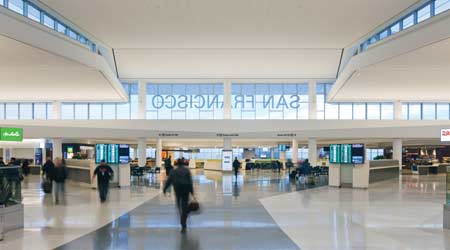 The designs for Terminal 2 and 3 at SFO incorporate biophilic design by using subtle shifts in pattern, lighting, and even ceiling height that provide a variety of experiences for the travelers who walk along the concourse to and from their gates. Nic Lehoux
The designs for Terminal 2 and 3 at SFO incorporate biophilic design by using subtle shifts in pattern, lighting, and even ceiling height that provide a variety of experiences for the travelers who walk along the concourse to and from their gates. Nic LehouxProduct Selection Criteria: Performance Transparency, Sustainable Materials
At SFO, product performance and chemical make-up are critical considerations when selecting products for the airport's terminals.
To date, much of the conversation about sustainable materials has focused on conservation of resources, but to ensure that the materials used do not cause harm to humans, it pays to dig a little deeper into what lies beneath the surface. Toxins like flame retardants are often found in upholstery foam and in some fabrics, and though this may seem like a smart way to protect human life, in reality these chemicals can cause harm to our health.
Understanding and confirming the latest and appropriate fire code for the space type is a good first step. California TB-117, enacted in the 1970s, is the rule that required furniture manufacturers to provide treated materials to meet strict fire safety standards, and influenced the industry for the entire nation. California released an update to its code in 2015, modifying the restrictions on foam and upholstery due to concerns from health advocates, a nationwide awareness of the potential negative health impacts of flame retardants, and considerable study into the actual performance of flame retardants, particularly in environments with robust sprinkler installations such as SFO. Until these chemicals are completely phased out, design teams need to remain vigilant in ensuring all new furniture is free of flame retardant. When selecting textiles, look for products that don’t need to be surface treated with chemicals, either for microbials or cleaning.
Transparency: The new normal
Product performance data play an important and evolving role in building design, construction, and operations, leading to improved performance, enhanced comfort, healthier environments, and increased project value. There is a growing expectation that everyone involved in a building project — from design to occupancy — should have access to information on potential health and environmental impacts relating to products. However, this is an age of misinformation, where baseless and misleading claims, intentional or not, continue to proliferate. Fortunately, advances in product measurement and verification, including life-cycle analysis, ingredient hazard assessment, and supply chain disclosure, are delivering more robust, science-based insight. These advances, combined with increased public disclosure directly by manufacturers, work to ensure that decision makers and influencers are able to access clear, reliable data.
Holding manufacturers to this higher level of performance transparency does more than force companies to stand behind claims: It provides the kind of proof needed to advance and experience true product innovation and building performance.
Kirsten Ritchie, PE, LEED AP O+M, LEED AP is a principal and a director of sustainable design for Gensler, based in San Francisco.
Melissa Mizell, IIDA, LEED AP ID+C is a principal and design director for Gensler, based in the Tokyo office.
Email comments to greg.zimmerman@tradepress.com.
Related Topics:














